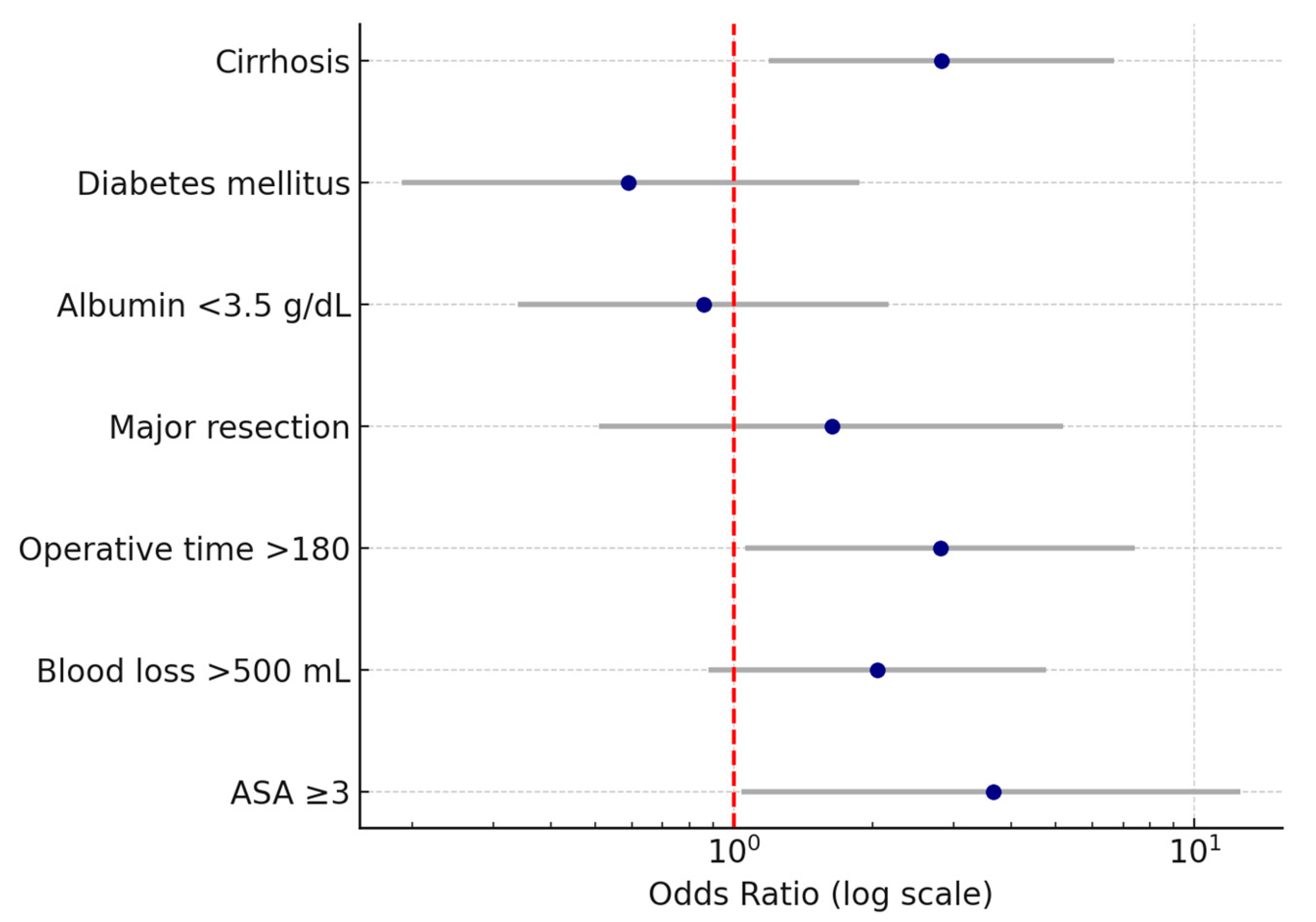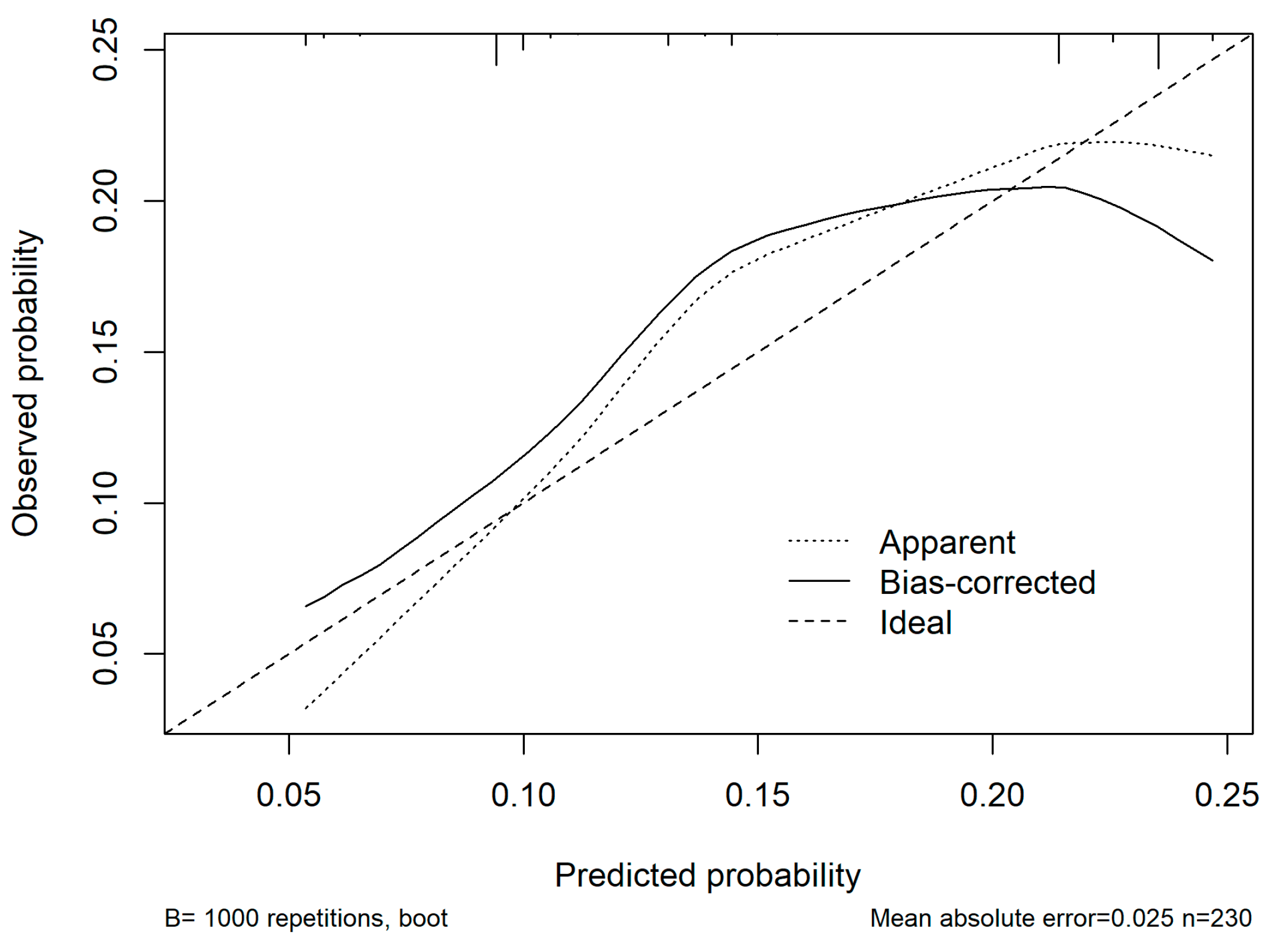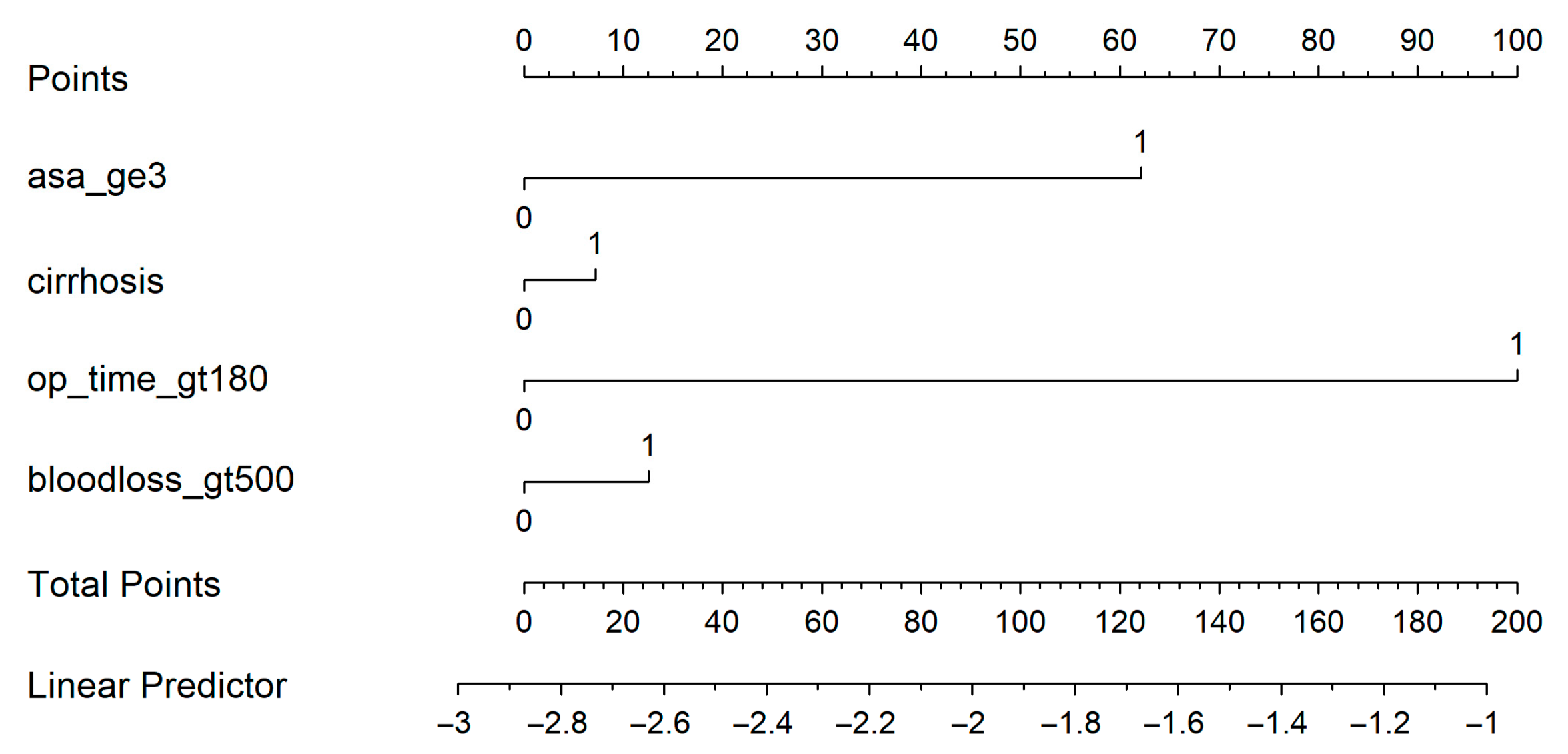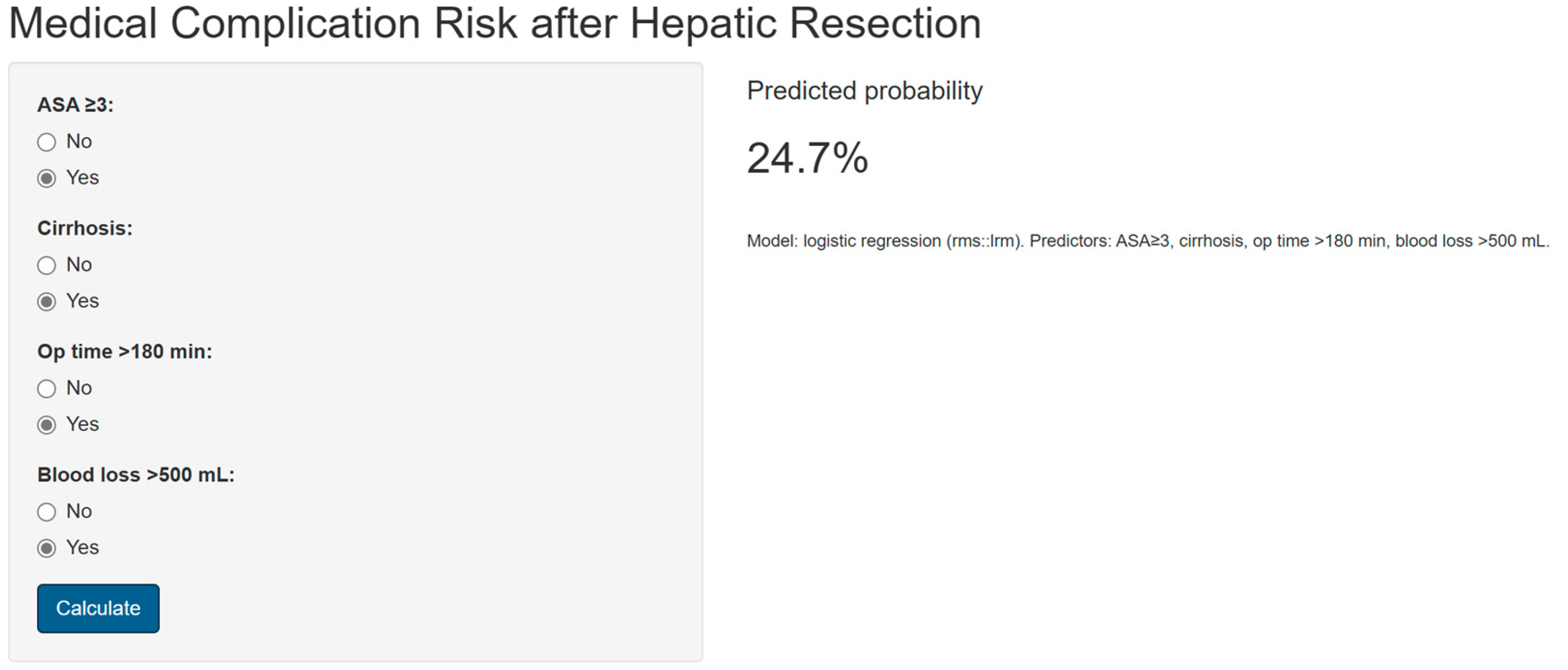Individualized Risk Prediction of Medical Postoperative Complications After Oncologic Hepatectomy: A Nomogram-Based Approach
Abstract
1. Introduction
2. Materials and Methods
2.1. Design and Setting
2.2. Inclusion and Exclusion Criteria
2.3. Data Extraction
2.4. Data Analysis
3. Results
3.1. Patient Characteristics
3.2. Incidence and Distribution of Postoperative Complications
3.3. Types of Postoperative Complications
3.4. Patient Profiles According to Complication Type
3.5. Multivariate Analysis of Predictors for Medical Complications
3.6. Individualized Risk Estimation Using the Nomogram Model
4. Discussion
5. Conclusions
Author Contributions
Funding
Institutional Review Board Statement
Informed Consent Statement
Data Availability Statement
Conflicts of Interest
Abbreviations
| AUC | Area Under the Curve |
| ASA | American Society of Anesthesiologists |
| ALT | Alanine Aminotransferase |
| AST | Aspartate Aminotransferase |
| BMI | Body Mass Index |
| CHT | Chemotherapy |
| CHF | Congestive Heart Failure |
| CI | Confidence Interval |
| CKD | Chronic Kidney Disease |
| COPD | Chronic Obstructive Pulmonary Disease |
| CRLM | Colorectal Liver Metastases |
| C-index | Concordance Index |
| HCC | Hepatocellular Carcinoma |
| INR | International Normalized Ratio |
| LOS | Length of Stay |
| mFI | Modified Frailty Index |
| MODS | Multiple Organ Dysfunction Syndrome |
| OR | Odds Ratio |
| PLT | Platelets |
| RCHT | Radiochemotherapy |
| RT | Radiotherapy |
| SD | Standard Deviation |
| STROBE | Strengthening the Reporting of Observational Studies in Epidemiology |
References
- Torielli, P.; McGale, J.; Liao, M.J.; Rhaiem, R.; Bouche, O.; Botsen, D.; Gerin, O.; Lamane, A.; Lawrence, Y.; Madelis, G.; et al. Hepatic metastases management: A comparative review of surgical resection, thermal ablation, and stereotactic body radiation therapy. Eur. J. Cancer 2025, 228, 115691. [Google Scholar] [CrossRef] [PubMed]
- Maki, H.; Hasegawa, K. Advances in the surgical treatment of liver cancer. Biosci. Trends 2022, 16, 178–188. [Google Scholar] [CrossRef] [PubMed]
- Harrison, J.M.; Visser, B.C. Cholangiocarcinoma. Surg. Clin. N. Am. 2024, 104, 1281–1293. [Google Scholar] [CrossRef] [PubMed]
- Bagante, F.; Ruzzenente, A.; Beal, E.W.; Campagnaro, T.; Merath, K.; Conci, S.; Akgül, O.; Alexandrescu, S.; Marques, H.P.; Lam, V.; et al. Complications after liver surgery: A benchmark analysis. HPB 2019, 21, 1139–1149. [Google Scholar] [CrossRef] [PubMed]
- Oliver, M.B.; Escrig-Sos, J.; Satre, F.R.; Moya-Herráiz, A.; Sabater-Ortí, L. Outcome quality standards for surgery of colorectal liver metastasis. Langenbecks Arch. Surg. 2020, 405, 745–756. [Google Scholar] [CrossRef]
- Huang, Z.Q.; Xu, L.; Yang, T.; Zhang, W.; Huang, X.; Cai, S.; Zhang, A.; Feng, Y.; Zhou, N.; Dong, J. Hepatic resection: An analysis of the impact of operative and perioperative factors on morbidity and mortality rates in 2008 consecutive hepatectomy cases. Chin. Med. J. 2009, 122, 2268–2277. [Google Scholar]
- Mullen, J.T.; Ribero, D.; Reddy, S.K.; Donadon, M.; Zorzi, D.; Gautam, S.; Abdalla, E.K.; Curley, S.A.; Capussotti, L.; Clary, B.M.; et al. Hepatic insufficiency and mortality in 1,059 noncirrhotic patients undergoing major hepatectomy. J. Am. Coll. Surg. 2007, 204, 854–862; discussion 862–864. [Google Scholar] [CrossRef] [PubMed]
- Memeo, R.; De Blasi, V.; Adam, R.; Goéré, D.; Laurent, A.; de’Angelis, N.; Piardi, T.; Lermite, E.; Herrero, A.; Navarro, F.; et al. Postoperative infectious complications impact long-term survival in patients who underwent hepatectomies for colorectal liver metastases: A propensity score matching analysis. J. Gastrointest. Surg. 2018, 22, 2045–2054. [Google Scholar] [CrossRef]
- van Mierlo, K.M.; Schaap, F.G.; Dejong, C.H.; Olde Damink, S.W. Liver resection for cancer: New developments in prediction, prevention and management of postresectional liver failure. J. Hepatol. 2016, 65, 1217–1231. [Google Scholar] [CrossRef] [PubMed]
- Ide, T.; Miyoshi, A.; Kitahara, K.; Noshiro, H. Prediction of postoperative complications in elderly patients with hepatocellular carcinoma. J. Surg. Res. 2013, 185, 614–619. [Google Scholar] [CrossRef] [PubMed]
- Sun, H.C.; Qin, L.X.; Wang, L.; Ye, Q.H.; Wu, Z.Q.; Fan, J.; Tang, Z.Y. Risk factors for postoperative complications after liver resection. Hepatobiliary Pancreat. Dis. Int. 2005, 4, 370–374. [Google Scholar] [PubMed]
- Lunca, S.; Morarasu, S.; Ivanov, A.A.; Clancy, C.; O’Brien, L.; Zaharia, R.; Musina, A.M.; Roata, C.E.; Dimofte, G.M. Is Frailty Associated with Worse, Outcomes After, Major Liver, Surgery? An, Observational Case-Control, Study. Diagnostics 2025, 15, 512. [Google Scholar] [CrossRef] [PubMed] [PubMed Central]
- Kabir, T.; Syn, N.L.; Tan, Z.Z.X.; Tan, H.J.; Yen, C.; Koh, Y.X.; Kam, J.H.; Teo, J.Y.; Lee, S.Y.; Cheow, P.C.; et al. Predictors of post-operative complications after surgical resection of hepatocellular carcinoma and their prognostic effects on outcome and survival: A propensity-score matched and structural equation modelling study. Eur. J. Surg. Oncol. 2020, 46, 1756–1765. [Google Scholar] [CrossRef] [PubMed]
- Xu, X.F.; Xing, H.; Han, J.; Li, Z.-L.; Lau, W.-Y.; Zhou, Y.-H.; Gu, W.-M.; Wang, H.; Chen, T.-H.; Zeng, Y.-Y.; et al. Risk factors, patterns, and outcomes of late recurrence after liver resection for hepatocellular carcinoma: A multicenter Study from China. JAMA Surg. 2019, 154, 209. [Google Scholar] [CrossRef] [PubMed]
- Lunca, S.; Morarasu, S.; Zaharia, R.; Ivanov, A.A.; Clancy, C.; O’Brien, L.; Ong, W.L.; Dimofte, G.M. Can We Achieve More with Less? Parenchymal Sparing Surgery Versus Major Liver Resection for Colorectal Liver Metastases: An Observational Single-Center Study with Propensity Score Analysis. Diagnostics 2025, 15, 1334. [Google Scholar] [CrossRef] [PubMed] [PubMed Central]
- Berardi, G.; Ratti, F.; Sposito, C.; Nebbia, M.; D’Souza, D.M.; Pascual, F.; Dogeas, E.; Tohme, S.; D’Amico, F.E.; Alessandris, R.; et al. Model to predict major complications following liver resection for HCC in patients with metabolic syndrome. Hepatology 2023, 77, 1527–1539. [Google Scholar] [CrossRef] [PubMed] [PubMed Central]
- Slankamenac, K.; Graf, R.; Barkun, J.; Puhan, M.A.; Clavien, P.A. The comprehensive complication index: A novel continuous scale to measure surgical morbidity. Ann. Surg. 2013, 258, 1–7. [Google Scholar] [CrossRef] [PubMed]
- von Elm, E.; Altman, D.G.; Egger, M.; Pocock, S.J.; Gøtzsche, P.C.; Vandenbroucke, J.P. STROBE Initiative. The Strengthening the Reporting of Observational, Studies in Epidemiology (STROBE) statement: Guidelines for reporting observational studies. J. Clin. Epidemiol. 2008, 61, 344–349. [Google Scholar] [CrossRef] [PubMed]
- Aloia, T.A.; Fahy, B.N.; Fischer, C.P.; Jones, S.L.; Duchini, A.; Galati, J.; Gaber, A.O.; Ghobrial, R.M.; Bass, B.L. Predicting poor outcome following hepatectomy: Analysis of 2313 hepatectomies in the NSQIP database. HPB 2009, 11, 510–515. [Google Scholar] [CrossRef] [PubMed] [PubMed Central]
- Lunca, S.; Morarasu, S.; Rouet, K.; Ivanov, A.A.; Morarasu, B.C.; Roata, C.E.; Clancy, C.; Dimofte, G.M. Frailty Increases Morbidity and Mortality in Patients Undergoing Oncological Liver Resections: A Systematic Review and Meta-analysis. Ann. Surg. Oncol. 2024, 31, 6514–6525. [Google Scholar] [CrossRef] [PubMed] [PubMed Central]
- Jarnagin, W.R.; Gonen, M.; Fong, Y.; DeMatteo, R.P.; Ben-Porat, L.; Little, S.; Corvera, C.; Weber, S.; Blumgart, L.H. Improvement in perioperative outcome after hepatic resection: Analysis of 1,803 consecutive cases over the past decade. Ann. Surg. 2002, 236, 397–406; discussion 406–407. [Google Scholar] [CrossRef] [PubMed] [PubMed Central]
- Scherman, P.; Syk, I.; Holmberg, E.; Naredi, P.; Rizell, M. Risk Factors for Postoperative Complications Following Resection of Colorectal Liver Metastases and the Impact on Long-Term Survival: A Population-Based National Cohort Study. World J. Surg. 2023, 47, 2230–2240. [Google Scholar] [CrossRef]
- Yang, S.; Ni, H.; Zhang, A.; Zhang, J.; Zang, H.; Ming, Z. Impact of postoperative morbidity on the prognosis of patients with hepatocellular carcinoma after laparoscopic liver resection: A multicenter observational study. Sci. Rep. 2025, 15, 1724. [Google Scholar] [CrossRef] [PubMed]
- Franken, L.C.; Schreuder, A.M.; Roos, E.; van Dieren, S.; Busch, O.R.; Besselink, M.G.; Van Gulik, T.M. Morbidity and mortality after major liver resection in patients with perihilar cholangiocarcinoma: A systematic review and meta-analysis. Surgery 2019, 165, 918–928. [Google Scholar] [CrossRef] [PubMed]
- McNelis, J.; Castaldi, M. The national surgery quality improvement project (NSQIP): A new tool to increase patient safety and cost efficiency in a surgical intensive care unit. Patient Saf. Surg. 2014, 8, 19. [Google Scholar] [CrossRef] [PubMed] [PubMed Central]
- Thomas, R.; Madani, R.; Worthington, T.; Karanjia, N. The usefulness of P-POSSUM score in patients undergoing elective liver resection for benign disease, metastatic colorectal cancer and non-colorectal cancer. Hepatogastroenterology 2012, 59, 2421–2427. [Google Scholar]
- Harimoto, N.; Shirabe, K.; Ikegami, T.; Yoshizumi, T.; Maeda, T.; Kajiyama, K.; Yamanaka, T.; Maehara, Y. Postoperative complications are predictive of poor prognosis in hepatocellular carcinoma. J. Surg. Res. 2015, 199, 470–477. [Google Scholar] [CrossRef]
- Longchamp, G.; Labgaa, I.; Demartines, N.; Joliat, G.R. Predictors of complications after liver surgery: A systematic review of the literature. HPB 2021, 23, 645–655. [Google Scholar] [CrossRef] [PubMed]
- Guo, M.M.; Ji, C.Y.; Gu, R.R.; Nan, K.; Miao, C.H.; Wu, Q.C. Risk factors and outcomes of intraoperative blood transfusion in elderly patients undergoing gastrointestinal cancer surgery. World J. Gastrointest. Surg. 2025, 17, 105860. [Google Scholar] [CrossRef] [PubMed] [PubMed Central]
- Wang, H.; Yang, J.; Yang, J.; Jiang, L.; Wen, T.; Wang, W.; Xu, M.; Li, B.; Yan, L. Development and validation of a prediction score for complications after hepatectomy in hepatitis B-related hepatocellular carcinoma patients. PLoS ONE 2014, 9, e105114. [Google Scholar] [CrossRef] [PubMed] [PubMed Central]
- Téoule, P.; Dunker, N.; Gölz, V.; Rasbach, E.; Reissfelder, C.; Birgin, E.; Rahbari, N.N. What matters in laparoscopic hepatectomy for lesions located in posterosuperior segments? Initial experiences and analysis of risk factors for postoperative complications: A retrospective cohort study. Surg. Endosc. 2025, 39, 3691–3701. [Google Scholar] [CrossRef] [PubMed] [PubMed Central]
- Nagata, M.; Hara, Y.; Hayakawa, S.; Komura, H.; Shibata, J.; Yamashita, C.; Nakamura, T.; Kuriyama, N.; Uchiyama, S.; Kawata, K.; et al. Retrospective study of predictive factors for postoperative complications of hepatectomies lasting 12 or more hours. Fujita Med. J. 2020, 6, 59–66. [Google Scholar] [CrossRef] [PubMed] [PubMed Central]
- Quireze, C., Jr.; Coelho, F.F.; Lima, A.S.; Marques, H.P.; Palavecino, M.; Pawlik, T.; Adam, R.; Soubrane, O.; Herman, P.; Cotta-Pereira, R.L. Complications After Hepatectomy. Arq. Bras. Cir. Dig. 2025, 37, e1856. [Google Scholar] [CrossRef] [PubMed] [PubMed Central]
- Watanabe, G.; Kawaguchi, Y.; Ichida, A.; Ishizawa, T.; Akamatsu, N.; Kaneko, J.; Arita, J.; Hasegawa, K. Understanding conditional cumulative incidence of complications following liver resection to optimize hospital stay. HPB 2022, 24, 226–233. [Google Scholar] [CrossRef]
- Delabays, C.; Demartines, N.; Joliat, G.R.; Melloul, E. Enhanced recovery after liver surgery in cirrhotic patients: A systematic review and meta-analysis. Perioper. Med. 2024, 13, 24. [Google Scholar] [CrossRef] [PubMed] [PubMed Central]





| n (%) | |
|---|---|
| Total | 231 |
| Gender (males) | 140 (60.6) |
| Age, mean (SD) | 62.8 |
| BMI | 26.43 ± 0.3 |
| mFI | |
| 0 | 92 (38.8) |
| 1 | 76 (32) |
| 2 | 46 (19.4) |
| 3 | 15 (6.3) |
| 4 | 2 (0.8) |
| Comorbidities | |
| Viral hepatitis | 79 (33.3) |
| Cirrhosis | 57 (24) |
| Diabetes | 49 (20.6) |
| CHF | 31 (13) |
| COPD | 20 (8.4) |
| CKD | 37 (15.6) |
| Smoking | 67 (28.2) |
| Neoadjuvant RT | 5 (2.1) |
| Neoadjuvant CHT | 55 (23.2) |
| Neoadjuvant RCHT | 29 (12.2) |
| ASA 2 | 52 (21.9) |
| ASA 3 | 156 (65.8) |
| Hepatocellular carcinoma | 96 (41.5) |
| Metastases | 121 (51) |
| Cholangiocarcinoma | 14 (6) |
| Preoperative blood tests | |
| Total bilirubin (mg/dL) | 0.89 ± 0.9 |
| Albumin (g/dL) | 4.14 ± 0.8 |
| INR | 1.49 ± 0.8 |
| PLT (mmc) × 103 | 215.9 ± 6,2 |
| AST | 62.9 ± 17.1 |
| ALT | 52.8 ± 14.9 |
| Operative factors | |
| Major resection | 39 (16.1) |
| No. of liver lesions (≥2) | 68 (28.7) |
| Operative time (min) | 234.5 ± 12.2 |
| Blood loss (mL) | 548.7 ± 57.3 |
| Complication Type | n | (%) |
|---|---|---|
| Medical | 20 | 8.6 |
| Surgical | 9 | 3.9 |
| Medical + Surgical | 7 | 3 |
| No complications | 195 | 84.4 |
| Total | n = 231 (100%) |
|---|---|
| Morbidity | n = 36 (15.6%) |
| Surgical complications | |
| Bile leaks | 2 (0.9) |
| Bleeding/hematoma | 4 (1.7) |
| Intra-abdominal collection | 6 (2.6) |
| Wound infection | 2 (0.9) |
| Bowel obstruction | 2 (0.9) |
| Medical complications | |
| Liver failure | 2 (0.9) |
| Pulmonary embolism | 2 (0.9) |
| Pneumopathy | 8 (3.4) |
| Cardiovascular | 5 (2.1) |
| Renal | 9 (3.9) |
| Mods | 1 (4.3) |
| Medical Complications n (%) 20 | Surgical Complications n (%) 9 | Medical and Surgical Complications n (%) 7 | No Complications n (%) 195 | p-Value Medical vs. Surgical | |
|---|---|---|---|---|---|
| Age, mean (SD) | 66.6 ± 3.2 | 53.5 ± 3 | 74.2 ± 4.2 | 62.37 ± 1.4 | <0.05 |
| Gender Males | 11 (55) | 5 (55.6) | 6 (85.7) | 122 (62.6) | 1 |
| BMI, mean (SD) | 27.6 ± 1.7 | 26.5 ± 3.3 | 26.7 ±2.3 | 26.45 ± 0.6 | 0.2 |
| ASA ≥ 3 Clavien-Dindo III-IV mFi > 2 | 15 (75) 10 (50) 4 (1.7) | 7 (77.8) 4 (44.4) 2 (0.9) | 6 (85.7) 4 (44.4) 3 (1.3) | 143 (73.3) 1 (57.1) 54 (23.4) | 1 1 1 |
| Cirrhosis | 5 (25) | 1 (11.1) | 2 (11.1) | 48 (28.6) | 0.6 |
| Diabetes mellitus | 3 (15) | 3 (33.3) | 2 (33.3) | 45 (28.6) | 0.3 |
| COPD | 2 (10) | 1 (11) | 1 (11.1) | 16 (14.3) | 1 |
| Low albumin (<3.5 g/dL) | 6 (30) | 4 (44.4) | 2 (44.4) | 49 (28.6) | 0.6 |
| Major resection | 7 (35) | 5 (55.6) | 1 (55.6) | 30 (14.3) | 0.4 |
| Operative time >180 (min) | 15 (75) | 9 (100) | 4 (57.1) | 107 (54.9) | <0.05 |
| Blood loss > 500 mL LOS | 11 (55) 8 ± 2.15 (±26.9%) | 4 (44.4) 6.77 ± 1.5 (±26%) | 1 (14.3) 9.57 ± 3.2 (±33.8%) | 64 (32.8) 5.42 ± 0.3 (±13.5%) | 0.6 <0.05 |
| Blood transfusion | 8 (40) | 3 (33.3) | 1 (14.2) | 25 (12.8) | 0.6 |
| Independent Variable | OR (Odds Ratio) | 95% CI | p-Value |
|---|---|---|---|
| Cirrhosis | 2.8 | 1.2–6.7 | <0.05 |
| Diabetes mellitus | 0.6 | 0.2–1.9 | 0.36 |
| Albumin < 3.5 g/dL | 0.8 | 0.3–2.2 | 0.75 |
| Major resection | 1.6 | 0.51–5.2 | 0.40 |
| Operative time > 180 | 2.8 | 1.1–7.4 | <0.05 |
| Blood loss > 500 mL | 2 | 0.9–4.8 | <0.05 |
| ASA ≥ 3 | 3.7 | 1.1–12.5 | <0.05 |
Disclaimer/Publisher’s Note: The statements, opinions and data contained in all publications are solely those of the individual author(s) and contributor(s) and not of MDPI and/or the editor(s). MDPI and/or the editor(s) disclaim responsibility for any injury to people or property resulting from any ideas, methods, instructions or products referred to in the content. |
© 2025 by the authors. Licensee MDPI, Basel, Switzerland. This article is an open access article distributed under the terms and conditions of the Creative Commons Attribution (CC BY) license (https://creativecommons.org/licenses/by/4.0/).
Share and Cite
Zaharia, R.; Morarasu, S.; Roata, C.E.; Musina, A.M.; Ong, W.L.; Dimofte, G.M.; Lunca, S. Individualized Risk Prediction of Medical Postoperative Complications After Oncologic Hepatectomy: A Nomogram-Based Approach. Med. Sci. 2025, 13, 267. https://doi.org/10.3390/medsci13040267
Zaharia R, Morarasu S, Roata CE, Musina AM, Ong WL, Dimofte GM, Lunca S. Individualized Risk Prediction of Medical Postoperative Complications After Oncologic Hepatectomy: A Nomogram-Based Approach. Medical Sciences. 2025; 13(4):267. https://doi.org/10.3390/medsci13040267
Chicago/Turabian StyleZaharia, Raluca, Stefan Morarasu, Cristian Ene Roata, Ana Maria Musina, Wee Liam Ong, Gabriel Mihail Dimofte, and Sorinel Lunca. 2025. "Individualized Risk Prediction of Medical Postoperative Complications After Oncologic Hepatectomy: A Nomogram-Based Approach" Medical Sciences 13, no. 4: 267. https://doi.org/10.3390/medsci13040267
APA StyleZaharia, R., Morarasu, S., Roata, C. E., Musina, A. M., Ong, W. L., Dimofte, G. M., & Lunca, S. (2025). Individualized Risk Prediction of Medical Postoperative Complications After Oncologic Hepatectomy: A Nomogram-Based Approach. Medical Sciences, 13(4), 267. https://doi.org/10.3390/medsci13040267





